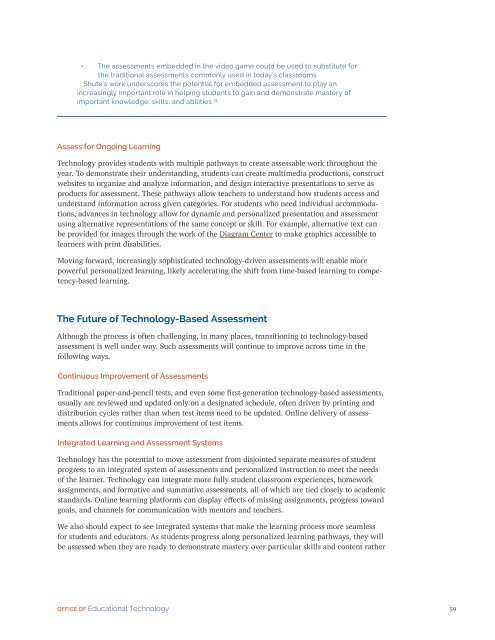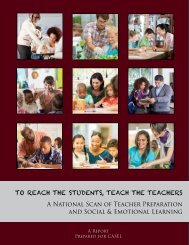Future Ready Learning
7m3sdJ
7m3sdJ
You also want an ePaper? Increase the reach of your titles
YUMPU automatically turns print PDFs into web optimized ePapers that Google loves.
• The assessments embedded in the video game could be used to substitute for<br />
the traditional assessments commonly used in today’s classrooms.<br />
Shute’s work underscores the potential for embedded assessment to play an<br />
increasingly important role in helping students to gain and demonstrate mastery of<br />
important knowledge, skills, and abilities. 21<br />
Assess for Ongoing <strong>Learning</strong><br />
Technology provides students with multiple pathways to create assessable work throughout the<br />
year. To demonstrate their understanding, students can create multimedia productions, construct<br />
websites to organize and analyze information, and design interactive presentations to serve as<br />
products for assessment. These pathways allow teachers to understand how students access and<br />
understand information across given categories. For students who need individual accommodations,<br />
advances in technology allow for dynamic and personalized presentation and assessment<br />
using alternative representations of the same concept or skill. For example, alternative text can<br />
be provided for images through the work of the Diagram Center to make graphics accessible to<br />
learners with print disabilities.<br />
Moving forward, increasingly sophisticated technology-driven assessments will enable more<br />
powerful personalized learning, likely accelerating the shift from time-based learning to competency-based<br />
learning.<br />
The <strong>Future</strong> of Technology-Based Assessment<br />
Although the process is often challenging, in many places, transitioning to technology-based<br />
assessment is well under way. Such assessments will continue to improve across time in the<br />
following ways.<br />
Continuous Improvement of Assessments<br />
Traditional paper-and-pencil tests, and even some first-generation technology-based assessments,<br />
usually are reviewed and updated only on a designated schedule, often driven by printing and<br />
distribution cycles rather than when test items need to be updated. Online delivery of assessments<br />
allows for continuous improvement of test items.<br />
Integrated <strong>Learning</strong> and Assessment Systems<br />
Technology has the potential to move assessment from disjointed separate measures of student<br />
progress to an integrated system of assessments and personalized instruction to meet the needs<br />
of the learner. Technology can integrate more fully student classroom experiences, homework<br />
assignments, and formative and summative assessments, all of which are tied closely to academic<br />
standards. Online learning platforms can display effects of missing assignments, progress toward<br />
goals, and channels for communication with mentors and teachers.<br />
We also should expect to see integrated systems that make the learning process more seamless<br />
for students and educators. As students progress along personalized learning pathways, they will<br />
be assessed when they are ready to demonstrate mastery over particular skills and content rather<br />
OFFICE OF Educational Technology<br />
59



